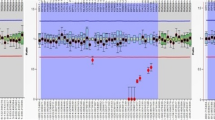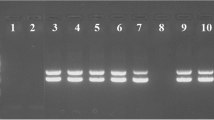Abstract
Purpose
To determine the prevalence of South Amerindian Y chromosome in Chilean patients with spermatogenic failure and their association with classical and/or AZFc-partial Y chromosome deletions.
Methods
We studied 400 men, 218 with secretory azo/oligozoospermia (cases) and 182 controls (116 fertile and/or normozoospermic, and 66 azoospermic with normal spermatogenesis). After a complete testicular characterization (physical evaluation, hormonal and/or biopsy) peripheral blood was drawn to obtain DNA for Y chromosome microdeletions, AZFc-partial deletions and biallelic analysis by allele specific polymerase chain reaction (PCR) of the M3 (rs3894) single nucleotide polymorphism (SNP).
Results
Classical AZF microdeletions were found in 23 cases (Y-microdeleted). AZFc-partial deletions were observed in 10 cases (6 “gr/gr”, 3 “b2/b3” and 1 “b1/b3”) and 4 controls (4 “gr/gr”). The AZFc-partial deletions were mainly associated with the absence of DAZ1/DAZ2 (64 %). No significant differences in the prevalence of AZFc-partial deletions were observed between cases and controls. We observed a significant higher proportion of the Q1a3a haplogroup in Y-microdeleted men compared to patients with spermatogenic failure without deletions and control men (P < 0.01 and P < 0.05, respectively by Bonferroni test). Among them, patients with AZFb deletions had an increased prevalence of the Q1a3a haplogroup compared to controls, cases without deletions and to those with complete or partial-AZFc deletions (P < 0.01, Bonferroni test).
Conclusions
The Q1a3a South Amerindian lineage seems to increase the susceptibility to non AZFc microdeletions. On the other hand, in Chilean population the AZFc-partial deletions (“gr/gr”, “b1/b3” and/or “b2/b3”) does not seem to predispose to severe spermatogenic impairment.

Similar content being viewed by others
References
Arredi B, Ferlin A, Speltra E, Bedin C, Zuccarello D, Ganz F, et al. Y-chromosome haplogroups and susceptibility to azoospermia factor c microdeletion in an Italian population. J Med Genet. 2007;44(3):205–8.
Bailliet G, Ramallo V, Muzzio M, Garcia A, Santos MR, Alfaro EL, et al. Brief communication: restricted geographic distribution for Y-Q* paragroup in South America. Am J Phys Anthropol. 2009;140(3):578–82.
Bhasin S. Approach to the infertile man. J Clin Endocrinol Metab. 2007;92(6):1995–2004.
Bianchi NO, Bailliet G, Bravi CM, Carnese RF, Rothhammer F, Martinez-Marignac VL, et al. Origin of Amerindian Y-chromosomes as inferred by the analysis of six polymorphic markers. Am J Phys Anthropol. 1997;102(1):79–89.
Blanco-Verea A, Jaime JC, Brion M, Carracedo A. Y-chromosome lineages in native South American population. Forensic Sci Int Genet. 2010;4(3):187–93.
Carrell DT. Elucidating the genetics of male infertility: understanding transcriptional and translational regulatory networks involved in spermatogenesis. Int J Androl. 2008;31(5):455–6.
Castro A, Zambrano N, Kaune H, Madariaga M, Lopez P, Mericq V. YqTER deletion causes arrest of spermatogenesis in early puberty. J Pediatr Endocrinol Metab. 2004;17(12):1675–8.
Cifuentes L, Morales R, Sepulveda D, Jorquera H, Acuna M. DYS19 and DYS199 loci in a Chilean population of mixed ancestry. Am J Phys Anthropol. 2004;125(1):85–9.
Cifuentes L, Valenzuela CY, Cruz-Coke R, Armanet L, Lyng C, Harb Z. Genetic characterization of the hospital population of Santiago, Chile. Rev Med Chil. 1988;116(1):28–33.
Consortium Y-C. A nomenclature system for the tree of human Y-chromosomal binary haplogroups. Genome Res. 2002;12(2):339–48.
Costa P, Goncalves R, Ferras C, Fernandes S, Fernandes AT, Sousa M, et al. Identification of new breakpoints in AZFb and AZFc. Mol Hum Reprod. 2008;14(4):251–8.
Ferlin A, Arredi B, Foresta C. Genetic causes of male infertility. Reprod Toxicol. 2006;22(2):133–41.
Ferlin A, Arredi B, Speltra E, Cazzadore C, Selice R, Garolla A, et al. Molecular and clinical characterization of Y chromosome microdeletions in infertile men: a 10-year experience in Italy. J Clin Endocrinol Metab. 2007;92(3):762–70.
Ferlin A, Raicu F, Gatta V, Zuccarello D, Palka G, Foresta C. Male infertility: role of genetic background. Reprod Biomed Online. 2007;14(6):734–45.
Fernandes AT, Fernandes S, Goncalves R, Sa R, Costa P, Rosa A, et al. DAZ gene copies: evidence of Y chromosome evolution. Mol Hum Reprod. 2006;12(8):519–23.
Foresta C, Moro E, Ferlin A. Y chromosome microdeletions and alterations of spermatogenesis. Endocr Rev. 2001;22(2):226–39.
Gianotten J, Lombardi MP, Zwinderman AH, Lilford RJ, van der Veen F. Idiopathic impaired spermatogenesis: genetic epidemiology is unlikely to provide a short-cut to better understanding. Hum Reprod Update. 2004;10(6):533–9.
Gonzalez-Neira A, Gusmao L, Brion M, Lareu MV, Amorim A, Carracedo A. Distribution of Y-chromosome STR defined haplotypes in Iberia. Forensic Sci Int. 2000;110(2):117–26.
Hopps CV, Mielnik A, Goldstein M, Palermo GD, Rosenwaks Z, Schlegel PN. Detection of sperm in men with Y chromosome microdeletions of the AZFa, AZFb and AZFc regions. Hum Reprod. 2003;18(8):1660–5.
Jezek D, Knuth UA, Schulze W. Successful testicular sperm extraction (TESE) in spite of high serum follicle stimulating hormone and azoospermia: correlation between testicular morphology, TESE results, semen analysis and serum hormone values in 103 infertile men. Hum Reprod. 1998;13(5):1230–4.
Johnsen SG. Testicular biopsy score count–a method for registration of spermatogenesis in human testes: normal values and results in 335 hypogonadal males. Hormones. 1970;1(1):2–25.
Jota MS, Lacerda DR, Sandoval JR, Vieira PP, Santos-Lopes SS, Bisso-Machado R, et al. A new subhaplogroup of native American Y-Chromosomes from the Andes. Am J Phys Anthropol. 2011;146(4):553–9.
Karafet TM, Mendez FL, Meilerman MB, Underhill PA, Zegura SL, Hammer MF. New binary polymorphisms reshape and increase resolution of the human Y chromosomal haplogroup tree. Genome Res. 2008;18(5):830–8.
Krausz C, Bussani-Mastellone C, Granchi S, McElreavey K, Scarselli G, Forti G. Screening for microdeletions of Y chromosome genes in patients undergoing intracytoplasmic sperm injection. Hum Reprod. 1999;14(7):1717–21.
Krausz C, Giachini C. Genetic risk factors in male infertility. Arch Androl. 2007;53(3):125–33.
Kruger TF, Ackerman SB, Simmons KF, Swanson RJ, Brugo SS, Acosta AA. A quick, reliable staining technique for human sperm morphology. Arch Androl. 1987;18(3):275–7.
Kuroda-Kawaguchi T, Skaletsky H, Brown LG, Minx PJ, Cordum HS, Waterston RH, et al. The AZFc region of the Y chromosome features massive palindromes and uniform recurrent deletions in infertile men. Nat Genet. 2001;29(3):279–86.
Lange J, Skaletsky H, van Daalen SK, Embry SL, Korver CM, Brown LG, et al. Isodicentric Y chromosomes and sex disorders as byproducts of homologous recombination that maintains palindromes. Cell. 2009;138(5):855–69. doi:10.1016/j.cell.2009.07.042.
Lardone MC, Parodi DA, Ebensperger M, Penaloza P, Cornejo V, Valdevenito R, et al. AZFc partial deletions in Chilean men with severe spermatogenic failure. Fertil Steril. 2007;88(5):1318–26.
Lewis Jr CM. Hierarchical modeling of genome-wide Short Tandem Repeat (STR) markers infers native American prehistory. Am J Phys Anthropol. 2010;141(2):281–9.
Ma K, Mallidis C, Bhasin S. The role of Y chromosome deletions in male infertility. Eur J Endocrinol. 2000;142(5):418–30.
Navarro-Costa P, Plancha CE, Goncalves J. Genetic dissection of the AZF regions of the human Y chromosome: thriller or filler for male (in)fertility? J Biomed Biotechnol. 2010;2010:936569.
Nuti F, Krausz C. Gene polymorphisms/mutations relevant to abnormal spermatogenesis. Reprod Biomed Online. 2008;16(4):504–13.
Repping S, Skaletsky H, Lange J, Silber S, Van Der Veen F, Oates RD, et al. Recombination between palindromes P5 and P1 on the human Y chromosome causes massive deletions and spermatogenic failure. Am J Hum Genet. 2002;71(4):906–22.
Rocco P, Morales C, Moraga M, Miquel JF, Nervi F, Llop E, et al. Genetic composition of the Chilean population. Analysis of mitochondrial DNA polymorphism. Rev Med Chil. 2002;130(2):125–31.
Sadeghi-Nejad H, Farrokhi F. Genetics of azoospermia: current knowledge, clinical implications, and future directions. Part II: Y chromosome microdeletions. Urol J. 2007;4(4):192–206.
Silber SJ. The Y chromosome in the era of intracytoplasmic sperm injection: a personal review. Fertil Steril. 2011;8:2439–48.
Skaletsky H, Kuroda-Kawaguchi T, Minx PJ, Cordum HS, Hillier L, Brown LG, et al. The male-specific region of the human Y chromosome is a mosaic of discrete sequence classes. Nature. 2003;423(6942):825–37.
Stouffs K, Lissens W, Tournaye H, Haentjens P. What about gr/gr deletions and male infertility? systematic review and meta-analysis. Hum Reprod Update. 2011;17(2):197–209.
Underhill PA, Jin L, Zemans R, Oefner PJ, Cavalli-Sforza LL. A pre-Columbian Y chromosome-specific transition and its implications for human evolutionary history. Proc Natl Acad Sci U S A. 1996;93(1):196–200.
Vogt P. Human chromosome deletions in Yq11, AZF candidate genes and male infertility: history and update. Mol Hum Reprod. 1998;4(8):739–44.
Wang S, Lewis CM, Jakobsson M, Ramachandran S, Ray N, Bedoya G, et al. Genetic variation and population structure in native Americans. PLoS Genet. 2007;3(11):e185.
WHO. Laboratory manual for the examination of human semen and sperm-cervical mucus interaction. 4th ed. Cambridge: Cambridge University Press; 1999.
Yang Y, Ma M, Li L, Zhang W, Chen P, Ma Y, et al. Y chromosome haplogroups may confer susceptibility to partial AZFc deletions and deletion effect on spermatogenesis impairment. Hum Reprod. 2008;23(9):2167–72.
Yang Y, Ma M, Li L, Zhang W, Xiao C, Li S, et al. Evidence for the association of Y-chromosome haplogroups with susceptibility to spermatogenic failure in a Chinese Han population. J Med Genet. 2008;45(4):210–5.
Zegura SL, Karafet TM, Zhivotovsky LA, Hammer MF. High-resolution SNPs and microsatellite haplotypes point to a single, recent entry of Native American Y chromosomes into the Americas. Mol Biol Evol. 2004;21(1):164–75.
Zhang F, Lu C, Li Z, Xie P, Xia Y, Zhu X, et al. Partial deletions are associated with an increased risk of complete deletion in AZFc: a new insight into the role of partial AZFc deletions in male infertility. J Med Genet. 2007;44(7):437–44.
Acknowledgments
We would like to thank all the men who generously accepted to participate in the study.
This work was supported by the Grant no. 1060081, National Fund for the Scientific and Technological Development (FONDECYT) of Chile.
Author information
Authors and Affiliations
Corresponding author
Additional information
Capsule
The Q1a3a South Amerindian lineage, defined by a C>T mutation in the DYS199 locus on the Y chromosome, seems to increase the susceptibility to AZF microdeletions in a Chilean population of infertile men.
Rights and permissions
About this article
Cite this article
Lardone, M.C., Marengo, A., Parada-Bustamante, A. et al. Greater prevalence of Y chromosome Q1a3a haplogroup in Y-microdeleted Chilean men: a case–control study. J Assist Reprod Genet 30, 531–538 (2013). https://doi.org/10.1007/s10815-013-9950-z
Received:
Accepted:
Published:
Issue Date:
DOI: https://doi.org/10.1007/s10815-013-9950-z




